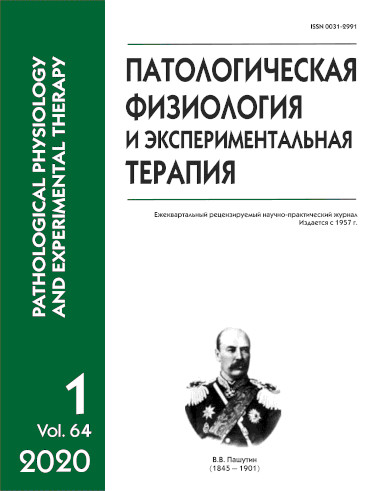Endothelial dysfunction and impairment of lymphatic drainage from tissues in the pathogenesis of diabetic microangiopathy
Abstract
Chronic vascular complications are the most dangerous complications of diabetes mellitus. The role of lymphatic system in the pathogenesis of diabetic microangiopathy is understudied. The aim of this study was to investigate the role of lipid peroxidation and endothelial dysfunction in disorders of lymph coagulation and lymphatic drainage from tissues on a model of streptozotocin diabetes mellitus and their significance in the pathogenesis of diabetic microangiopathy. Methods. Experiments were performed on 23 Chinchilla rabbits in compliance with all rules for conducting experiments on laboratory animals. Diabetes mellitus was modeled with an intraperitoneal injection of streptozotocin (Keocyt, Malakoff, France) dissolved in 1 ml of 0.9% NaCl at a dose of 50 mg/kg. Animals fasted overnight before the injection. Control rabbits (n=4) received an injection of 0.9% NaCl solution instead of streptozotocin. Peroxide oxidation of lipids in lymph is appreciated in the level of diene conjugates, malonic dialdehyde and amount of reduced glutathione. For assessments the state of coagulation of lymph is determined: activated partial thromboplastin time, prothrombin time, Willebrand factor, thrombin time, concentration of fibrinogen, dissolved fibrin monomeric complexes, products of degradation of fibrinogen, antithrombin III and fibrinolytic activity. Indices of coagulation of lymph determined on semi-automatic coagulometer «Humaclot -Duo» (Germany) with ready set of reagents firm of «Human» (Germany) «Coagulotest» (Russia). The state of drainage function of lymphatic system of the heart is investigated during injection of lymphotropic dyes. Results. Streptozotocin diabetes mellitus activated lipid peroxidation, which resulted in endothelial dysfunction and discharge of procoagulants into both the blood and lymph. This facilitated intravascular lymph coagulation and inhibition of lymphatic drainage from tissues associated with accumulation of toxic metabolites in the interstitial space around blood and lymphatic capillaries and development of vascular complications. The changes in hemolymphatic balance affected microcirculation of organs, as evidenced by the impaired drainage function of the heart lymphatic system in experimental diabetes mellitus. Incomplete drainage of cell decay products, large molecular particles, and toxic metabolites and their accumulation in the interstitium adversely affect the microhemo- and microlymphocirculation and, thereby, plays a major role in the pathogenesis of diabetic microangiopathy. Conclusion. In development of preventive measures for diabetic microangiopathy, the state of lymphatic drainage from tissues, particularly in the heart, should be taken into account.






